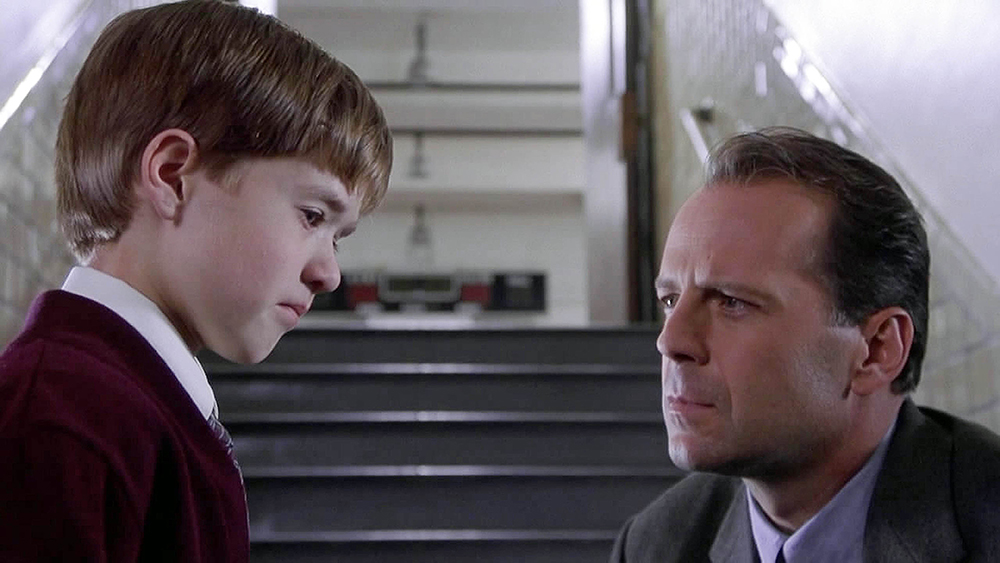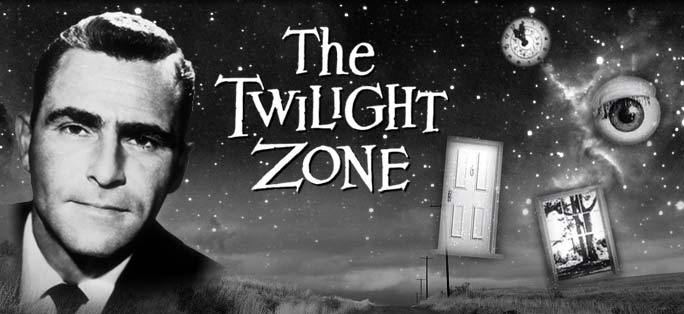Horror stories and twist endings go together like peanut butter and jelly.
They both achieve results by surprising the reader in some way. They catch us off guard, creating an emotional afterburn that lingers on.
But how do you accomplish this, as a writer?
The Key to Twist Endings
The key to twist endings (or twist middles, in some cases) can be summed up in a single sentence:
You have to lead the reader or viewer down one path, and then alter course abruptly with some new element or revelation.
The course change shouldn’t be random, forced, or unnatural. But it should be unexpected. It should be something that the reader probably doesn’t see coming.
Have you seen the movie The Sixth Sense? If not, don’t worry. I won’t spoil anything.

That movie has one of the most famous twists in cinema history. I didn’t see it coming the first time I watched that movie, and it left my mouth hanging open in surprise.
More importantly, it changed the context of the entire story.
That’s the hallmark of a good horror story twist. You’re reading the story, and you think you have a pretty good grasp as to what it’s about. But then the twist comes along and changes everything you just read.
How to Write a Horror Story With a Twist: 7 Techniques
We’ve laid the groundwork. Now let’s get specific.
Here are seven ways you could create a twist within a horror short story, novel, or screenplay.
1. Reverse the victim and the monster.
With this approach, you start off by making the protagonist appear to be the victim, only to reveal later that they are the true monster or villain. The initial “victim” becomes the terrifying antagonist.
To take it further, the original creature might turn out to be misunderstood, innocent, or even sympathetic.
2. Change the nature of the threat.
Here’s another strategy for creating a horror story twist. You start off with a conventional and familiar threat, like a ghost or a serial killer. Then you twist it by revealing that the true threat is something completely unexpected, like a psychological breakdown or evil experiment.
Check out the 2011 movie The Cabin in the Woods to see this concept in action.
3. Combine science fiction and horror.
Some horror stories start off with a science fiction premise and setting, before introducing the horror element. This creates an unexpected twist.
The novel Blindsight by Peter Watts demonstrates this kind of twist. It starts off as a classic “first contact” science fiction story, before introducing the chilling elements.
In the movie world, you can see this model well executed in the 1979 film Alien. The movie begins with a purely sci-fi premise (a mysterious signal in space) before turning into a terrifying creature feature.
Do you like this concept? If so, check out my guide to writing sci-fi horror and this collection of interesting story ideas.
4. Combine horror with some other genre.
We just talked about the sci-fi horror mashup, and how it can create twists and surprises within a story or novel.
But it doesn’t have to be a science fiction crossover. You could mix horror with just about any other genre, to create something fresh and unexpected, as in the following examples.
- Comedy: A group of friends on a road trip to a horror convention encounter real-life horrors.
- Dystopian: A rebel fighting against a totalitarian regime discovers that the true enemy is a monstrous creature lurking in the shadows.
- Fantasy: A magical kingdom faces a curse that turns its inhabitants into monsters every full moon.
- Historical Fiction: In medieval Europe, a village’s water supply is poisoned, leading to a plague—and whispers of supernatural punishment.
- Mystery: A detective investigating a series of bizarre murders uncovers a supernatural force behind the killings.
- Noir/Crime: A hardened investigator is hired to find a missing person in the seedy underworld, but the case leads him to a cult practicing dark rituals.
- Romance: A couple on a romantic getaway discovers a sinister secret about the secluded cabin they’ve rented.
- Survival: A mountaineering team becomes trapped in a snowstorm, only to realize they are not alone in the wilderness.
- Thriller: An escaped prisoner flees to a remote town only to find himself hunted by an ancient, unseen terror.
- Western: A group of cowboys sitting around a campfire come to realize their cattle drive has disturbed an ancient spirit.
- Young Adult: A group of friends at summer camp uncover an ancient artifact, unleashing a supernatural force that feeds on fear.
In all of these examples, the basic concept is the same. You’re introducing a story that seems to fit squarely into a specific genre (western, science fiction, detective), and then catching the reader off guard with the horror twist.
5. Alter time or reality in your story.
With this twisty approach, you would introduce a time loop or altered perception of reality within your horror story.
The characters gradually come to realize that they are trapped in an inescapable situation, or that the past events aren’t what they seemed. Unfortunately, this realization comes too late to save them.
6. Use an unreliable narrator.
In fiction, an unreliable narrator misleads the reader either intentionally or inadvertently. This literary device can lead to a shocking twist, especially when applied to a horror story.
You lead the reader to believe in one version of events through a biased narrator, but later reveal that the narrator was hiding or distorting the truth.
You could incorporate hallucinations and delusions as well. Maybe the narrator thinks they’re telling the truth, but only because their own mind has been compromised.
7. Introduce a “false ending.”
In this twist, you lead the reader to believe the horror has ended and the characters are safe, only to pull them back into a more terrifying situation. A “false ending” gives the reader a breather—sometimes even relief—before plunging the characters back into danger.
This twist can be especially effective in horror because it plays with the reader’s expectations. It makes the story feel complete right before delivering a final, shocking reveal.
Example: A haunted house story where the protagonist manages to “escape” the house, only to discover that the evil entity has followed them home, or that their own home is now possessed.
Twisty Inspiration From Books, TV, and Movies
You can also get ideas for a horror story twist by seeing how it’s been done in the past. Here are some twisty TV shows, books, and movies that might offer inspiration.

Classic Anthology TV Shows
- The Twilight Zone (1959-1964): This series was famous for its mind-blowing twist endings. Each episode explores a different moral or psychological scenario, often with a surreal or supernatural element, and concludes with a surprising revelation.
- Alfred Hitchcock Presents (1955-1965): Like The Twilight Zone, this series often featured suspenseful, eerie stories with shocking final reveals.
- The Outer Limits (1963-1965): This show featured more sci-fi elements than horror, but it often concluded with a mind-bending or unsettling twist.
- Tales from the Crypt (1989-1996): Known for their horror and dark humor, Crypt episodes usually wrapped up with some kind of morbid, ironic twist.
Modern TV Shows and Movies
- Black Mirror (2011-present): This series often uses technology-based horror or dystopian themes with many episodes featuring clever, dark twists.
- M. Night Shyamalan: Films like The Sixth Sense (1999), Unbreakable (2000), and The Village (2004) deliver unexpected endings that make you rethink the entire story.
- Jordan Peele’s Horror Films: Films like Get Out (2017) and Us (2019) include layers of social commentary and horror with surprising twists.
Classic Literature
- Edgar Allan Poe: Many of Poe’s short stories (like The Tell-Tale Heart and The Cask of Amontillado) have unnerving twists that incorporate psychological horror and guilt.
- Shirley Jackson: Stories like The Lottery and We Have Always Lived in the Castle allow the dread to build slowly before reaching a shocking or disturbing ending.
Mystery and Thriller Novels
- Agatha Christie: Some of Christie’s novels, like And Then There Were None and Murder on the Orient Express, use twist endings where the culprit’s identity comes as a shocking revelation.
- Gillian Flynn: Flynn’s novels, like Gone Girl (2012), use unreliable narrators and psychological suspense to deliver powerful and disturbing twists.
When and Where to Introduce the Twist
When writing a horror story with a twist, you have to carefully consider the timing. Revealing it too early could lead to an anti-climactic second half. On the other hand, introducing it too late could weaken the entire story.
When and where you introduce the twist will depend on the type of story you’re writing. My advice is to trust your instincts and do whatever results in a more engaging story.
Here are some options for timing the twist:
- Near the Climax: A twist close to the climax intensifies the suspense and raises stakes at a key moment in the story. It adds new depth and context, right before the final showdown.
- Midpoint Reversal: A twist at the midpoint can change the story’s entire direction. This keeps readers engaged by changing their expectations and forcing the characters to adapt to new threats.
- Bit by Bit: Sometimes, layering small twists throughout the story works best. Each one reveals some new facet of the horror, some disturbing revelation. This slow-burn approach maintains suspense while gradually building toward a bigger reveal.
- The End of the Story: A last-minute twist can leave a lasting impact, making readers re-evaluate everything they’ve just read. This method works particularly well in short stories by making the chill linger.
Horror writing is a creative process with very few guardrails. It allows you to push boundaries and blaze your own path. So these certainly aren’t the only ways to add twists to your story.
My advice, in closing, is to read some works that are known for having well-executed twists and surprises. See how successful authors have done it in the past, and then put your own stamp on it.
